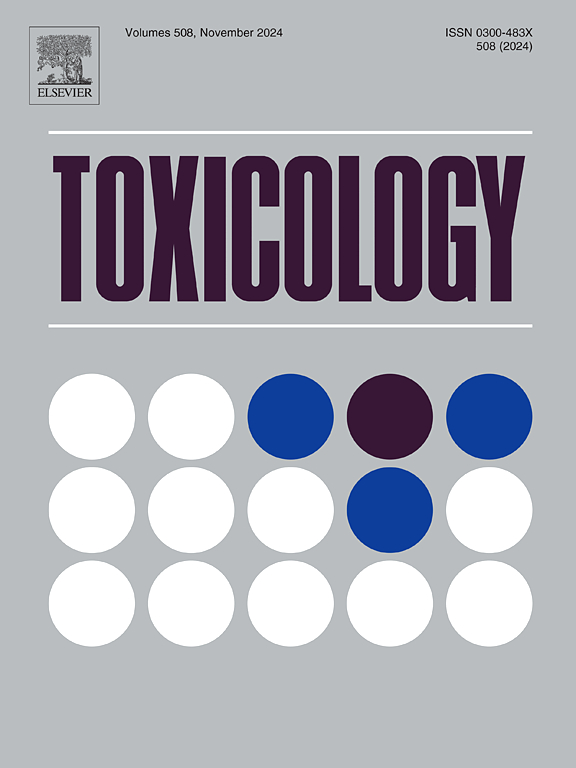Glutathione attenuates diesel exhaust-induced lung epithelial injury via NF-κB/Nrf2/GPX4-mediated ferroptosis
IF 4.8
3区 医学
Q1 PHARMACOLOGY & PHARMACY
引用次数: 0
Abstract
Diesel exhaust (DE) emissions pose a significant threat to public health. This study linked DE-mediated reactive oxygen species (ROS) and ferroptosis with lung epithelial disruption, also the protective potential of exogenous glutathione (GSH) administration was investigated. C57BL/6 mice were divided into three groups: filtered air (control), DE exposed, and DE+GSH (administered intranasally on alternate days). Airway hyperresponsiveness (AHR), lung tissues, and bronchoalveolar lavage fluid (BALF) were used for analysis. DE exposure significantly impaired lung function parameters as shown by AHR. Elevated ROS depleted the GSH/GSSG ratio and suppressed Nrf2 activity, disrupting antioxidant defense mechanisms, which were restored by GSH administration. DE-induced ROS acted as a key driver of ferroptosis, characterized by suppressed SLC7411 expression thereby decreased GSH synthesis and GPX-4 activity, inducing lipid peroxidation. Ferroptosis was significantly mitigated by increased GSH pool, which restored GPX-4 levels and reduced lipid peroxidation. Concurrently, DE induced ROS promoted DNA damage and apoptosis in lung epithelial cells wherein GSH treatment preserved cell survival in DE exposed mice. The heightened DE-associated ROS further amplified inflammation, as shown by increased cytokines (TNF-α, IL-6, TSLP, IL-33) and P-NF-κB activation. Activated inflammatory cascade disrupted tight junction proteins (claudins, occludin), resulted in weakened epithelial barrier and increased permeability. Lung barrier disruption was evidenced by transmission electron microscopy and immunohistochemistry, corroborated with elevated albumin levels. GSH effectively restored tight junction integrity and preserved barrier function in DE+GSH mice lungs. In conclusion, DE-induced oxidative stress and ferroptosis-triggered inflammation compromised epithelial barrier promoting lung injury. Exogenous GSH administration showed potential in restoring DE-associated lung damage.
谷胱甘肽通过 NF-κB/Nrf2/GPX4 介导的铁氧化作用减轻柴油废气诱导的肺上皮损伤
柴油废气(DE)排放对公众健康构成重大威胁。本研究将de介导的活性氧(ROS)和铁下沉与肺上皮破坏联系起来,并研究了外源性谷胱甘肽(GSH)给药的保护潜力。C57BL/6小鼠分为三组:过滤空气组(对照组)、DE暴露组和DE+GSH组(隔天鼻内给药)。采用气道高反应性(AHR)、肺组织和支气管肺泡灌洗液(BALF)进行分析。AHR显示,DE暴露显著损害肺功能参数。升高的ROS降低了GSH/GSSG的比例,抑制了Nrf2的活性,破坏了GSH恢复的抗氧化防御机制。de诱导的ROS是铁死亡的关键驱动因素,其特征是抑制SLC7411表达,从而降低GSH合成和GPX-4活性,诱导脂质过氧化。GSH池的增加显著减轻了铁下垂,恢复了GPX-4水平,减少了脂质过氧化。同时,DE诱导的ROS促进肺上皮细胞DNA损伤和凋亡,其中GSH处理保留了DE暴露小鼠的细胞存活。de相关ROS的升高进一步放大了炎症,表现为细胞因子(TNF-α、IL-6、TSLP、IL-33)和P-NF-κB活化的增加。激活的炎症级联破坏紧密连接蛋白(claudin, occludin),导致上皮屏障减弱和通透性增加。透射电镜和免疫组织化学证实肺屏障破坏,白蛋白水平升高。GSH有效地恢复了DE+GSH小鼠肺紧密连接的完整性,并保留了屏障功能。总之,de诱导的氧化应激和铁中毒引发的炎症损害上皮屏障,促进肺损伤。外源性GSH给药显示出恢复de相关肺损伤的潜力。
本文章由计算机程序翻译,如有差异,请以英文原文为准。
求助全文
约1分钟内获得全文
求助全文
来源期刊

Toxicology
医学-毒理学
CiteScore
7.80
自引率
4.40%
发文量
222
审稿时长
23 days
期刊介绍:
Toxicology is an international, peer-reviewed journal that publishes only the highest quality original scientific research and critical reviews describing hypothesis-based investigations into mechanisms of toxicity associated with exposures to xenobiotic chemicals, particularly as it relates to human health. In this respect "mechanisms" is defined on both the macro (e.g. physiological, biological, kinetic, species, sex, etc.) and molecular (genomic, transcriptomic, metabolic, etc.) scale. Emphasis is placed on findings that identify novel hazards and that can be extrapolated to exposures and mechanisms that are relevant to estimating human risk. Toxicology also publishes brief communications, personal commentaries and opinion articles, as well as concise expert reviews on contemporary topics. All research and review articles published in Toxicology are subject to rigorous peer review. Authors are asked to contact the Editor-in-Chief prior to submitting review articles or commentaries for consideration for publication in Toxicology.
 求助内容:
求助内容: 应助结果提醒方式:
应助结果提醒方式:


